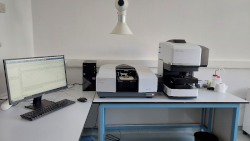Fourier Transform Infrared Spectrometer
Device: Shimadzu IRTracerTM-100 Fourier Transform Infrared Spectrometer
Accessories and Working Range:
• GladiATR 10 (Mid-IR (400-4000cm-1))
• AIMsight Infrared Microscope (Mid-IR (650-4000 cm-1))
- ATR Lens (Ge)
- Grazing Angle Objective
- Diamond Cell CII

Sample Properties: Samples to be sent for analysis may be in powder, solid block, film, coating or liquid form. In powder samples, it should be between 25-50 mg (but these amounts may vary depending on the type of study). For liquid samples, it should be between 10-20 ml.
For microscope and microplastic analyses, please contact the laboratory (mlabkorl![]() metu [dot] edu [dot] tr).
metu [dot] edu [dot] tr).
Applications:
-
ATR Drugs
-
ATR Inorganics
-
ATR Organics
-
ATR Polymer
-
ATR Adhesives and Sealents
-
Comprehensive Organics
-
ATR Cosmetics
-
ATR Dyes
-
ATR Essential Oils
-
Drugs / Canadian Forensic
-
Minerals & Inorganics
-
Organic Compounds
-
Polymers & Polymer Additives
-
Surfactants
-
Forensics
-
Vapor Phase Organic Compounds
-
UV-Degradation Library for Plastics
-
Thermo-Degradation Library for Plastics
-
Pollution Library
Device: Shimadzu IRTracerTM-100 Fourier Transform Infrared Spectrometer
Accessories and Working Range:
• GladiATR 10 (Mid-IR (400-4000cm-1))
• AIMsight Infrared Microscope (Mid-IR (650-4000 cm-1))
- ATR Lens (Ge)
- Grazing Angle Objective
- Diamond Cell CII

Sample Properties: Samples to be sent for analysis may be in powder, solid block, film, coating or liquid form. In powder samples, it should be between 25-50 mg (but these amounts may vary depending on the type of study). For liquid samples, it should be between 10-20 ml.
For microscope and microplastic analyses, please contact the laboratory (mlabkorl![]() metu [dot] edu [dot] tr).
metu [dot] edu [dot] tr).
Applications:
-
ATR Drugs
-
ATR Inorganics
-
ATR Organics
-
ATR Polymer
-
ATR Adhesives and Sealents
-
Comprehensive Organics
-
ATR Cosmetics
-
ATR Dyes
-
ATR Essential Oils
-
Drugs / Canadian Forensic
-
Minerals & Inorganics
-
Organic Compounds
-
Polymers & Polymer Additives
-
Surfactants
-
Forensics
-
Vapor Phase Organic Compounds
-
UV-Degradation Library for Plastics
-
Thermo-Degradation Library for Plastics
-
Pollution Library
